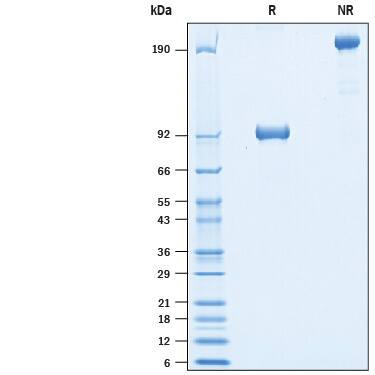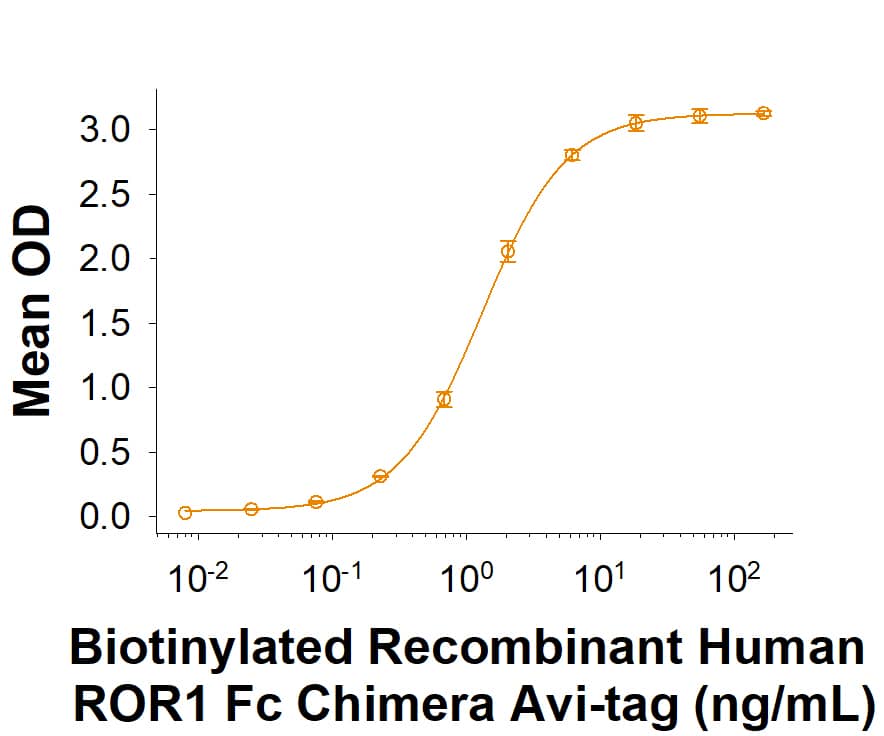Recombinant Human ROR1 Fc Chimera Avi-tag Protein, CF
R&D Systems, part of Bio-Techne | Catalog # AVI9490
Biotinylated

Key Product Details
Learn more about Avi-tag Biotinylated Proteins
Source
HEK293
Accession #
Structure / Form
Disulfide-linked homodimer
Conjugate
Biotin
Applications
Bioactivity
Product Specifications
Source
Human embryonic kidney cell, HEK293-derived human ROR1 protein
| Human ROR1 (Ala24-Glu403) Accession # Q01973 |
IEGRMD | Human IgG1 (Pro100-Lys330) |
GG | Avi-tag |
Purity
>95%, by SDS-PAGE visualized with Silver Staining and quantitative densitometry by Coomassie® Blue Staining.
Endotoxin Level
<0.10 EU per 1 μg of the protein by the LAL method.
N-terminal Sequence Analysis
Ala24
Predicted Molecular Mass
71 kDa
SDS-PAGE
85-105 kDa, under reducing conditions
Activity
Measured by its binding ability in a functional ELISA.
When Human ROR1 Antibody (Catalog # MAB20001) is immobilized at 0.5 µg/mL (100 µL/well), Biotinylated Recombinant Human ROR1 Fc Chimera Avi-tag (Catalog # AVI9490) binds with an ED50 of 0.6-3.6 ng/mL.
Measured by its binding ability in a functional ELISA.
When Recombinant Human/Mouse Wnt-5a Recombinant Human/Mouse Wnt‑5a (Catalog # 645-WN) is immobilized at 4 µg/mL (100 µL/well), Biotinylated Recombinant Human ROR1 Fc Chimera Avi-tag (Catalog # AVI9490) binds with an ED50 of 5-40 μg/mL.
When Human ROR1 Antibody (Catalog # MAB20001) is immobilized at 0.5 µg/mL (100 µL/well), Biotinylated Recombinant Human ROR1 Fc Chimera Avi-tag (Catalog # AVI9490) binds with an ED50 of 0.6-3.6 ng/mL.
Measured by its binding ability in a functional ELISA.
When Recombinant Human/Mouse Wnt-5a Recombinant Human/Mouse Wnt‑5a (Catalog # 645-WN) is immobilized at 4 µg/mL (100 µL/well), Biotinylated Recombinant Human ROR1 Fc Chimera Avi-tag (Catalog # AVI9490) binds with an ED50 of 5-40 μg/mL.
Scientific Data Images for Recombinant Human ROR1 Fc Chimera Avi-tag Protein, CF
Recombinant Human ROR1 Fc Chimera Avi-tag Protein Binding Activity
When Human ROR1 Antibody (Catalog # MAB20001) is immobilized at 0.5 µg/mL (100 µL/well), Biotinylated Recombinant Human ROR1 Fc Chimera Avi-tag (Catalog # AVI9490) binds with an ED50 of 0.6-3.6 ng/mL.Recombinant Human ROR1 Fc Chimera Avi-tag Protein SDS-PAGE
2 μg/lane of Biotinylated Recombinant Human ROR1 Fc Chimera Avi-tag (Catalog # AVI9490) was resolved with SDS-PAGE under reducing (R) and non-reducing (NR) conditions and visualized by Coomassie® Blue staining, showing bands at 85-105 kDa and 170-210 kDa, respectively.Formulation, Preparation and Storage
AVI9490
| Formulation | Lyophilized from a 0.2 μm filtered solution in PBS with Trehalose. |
| Reconstitution | Reconstitute at 500 μg/mL in PBS. |
| Shipping | The product is shipped at ambient temperature. Upon receipt, store it immediately at the temperature recommended below. |
| Stability & Storage | Use a manual defrost freezer and avoid repeated freeze-thaw cycles.
|
Background: ROR1
References
- Aghebati-Maleki, L. et al. (2017) Biomed. Pharmacother. 88:814.
- Borcherding N. et al. (2014) Protein Cell. 5:496.
- Masiakowski P. and Carroll R.D. (1992) J. Biol. Chem. 267:26181.
- Fukuda T. et al. (2008) Proc. Natl. Acad. Sci. U.S.A. 105:3047.
Long Name
Receptor Tyrosine Kinase-like Orphan Receptor 1
Alternate Names
NTRKR1
Gene Symbol
ROR1
UniProt
Additional ROR1 Products
Product Documents for Recombinant Human ROR1 Fc Chimera Avi-tag Protein, CF
Product Specific Notices for Recombinant Human ROR1 Fc Chimera Avi-tag Protein, CF
For research use only
